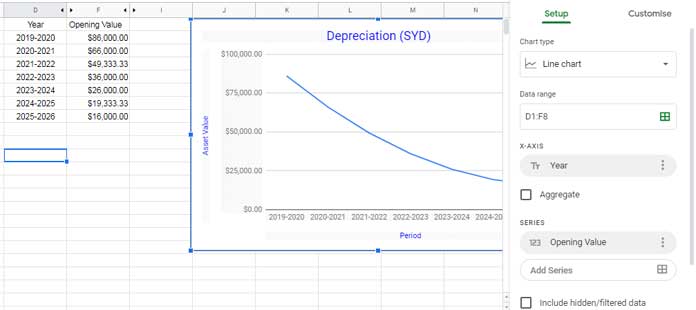The SYD function in Google Sheets is for finding depreciation using the sum of years’ digit method. There are six financial functions in Google Sheets for calculating depreciation of an asset. The SYD function is one among them.
One of the questions that may quite disturb you is which depreciation method you should follow, right?
Which function or method you should follow depends on several things including the type of tangible asset you want to depreciate and the legal requirements.
Understanding the sum of years’ digit method is a must to learn Google Sheets SYD function. It will help you whether you should follow this function for finding depreciation in Google Docs Sheets.
Sum of Years’ Digit Method aka SYD
Assume you have a piece of equipment and aging can reduce the production capacity of it. In such a case, you can follow the SYD method to find the depreciation as it charges a higher depreciation expense at the initial years of the useful product life.
SYD is actually one of the accelerated depreciation methods which allow the deduction of higher expenses in the initial years of the purchased asset.
If the useful life of the piece of equipment is 6 years, then the depreciation percentage in each year using the sum of years’ digit method can be calculated as follows.
Sum of the years = 1+2+3+4+5+6 = 21 years.
Life of the equipment = 6 years.
Percentage of deduction in the first year = 6/21 = 28.57%
Percentage of deduction in the second year = 5/21 = 23.81%
Third year it would be 4/21, fourth year 3/21, fifth year 2/21 and the sixth year 1/21.
That means depreciation is equal to;
(cost-salvage)* the above each percentage for each periodThe SYD Function Syntax in Google Sheets
SYD(cost, salvage, life, period)Arguments:
cost – Initial cost of asset.
salvage – It’s the scrap value. That means the asset value at the end of depreciation.
life – The useful life of the asset or the number of periods over which the asset is depreciated.
period – The period within “life” for which to calculate depreciation. It’s a single period, not period from … to …
SYD Formula Example in Google Sheets
I have the following input values. See how to depreciate an asset value using the sum of the years’ digit method in Google Sheets
| A | B | |
| 1 | Cost | $86,000.00 |
| 2 | Salvage (Scrap value) | $16,000.00 |
| 3 | Life | 6 |
| 4 | Period | 1 |
Formula:
=SYD(B1,B2,B3,B4)Result: $20,000.00
To allocate the cost of your tangible asset, you can prepare a table like this from the above input values.

You can see that the “life” of the asset is 6 years and the depreciation value in each year (column E) is calculated in column G.
Since SYD is an accelerate depreciation function, the depreciation amount in the initial years will be higher. You can check that on the table.
At the end of the useful “life” of the asset, the value of the asset will be equal to its scrap value (salvage). I have marked that on the screenshot.
I have used the following formulas to prepare the above depreciation schedule. No doubt, the SYD function in Google Sheets is the main part in it.
The SYD formula in Cell G2 to calculate the depreciation for the period 1:
=syd($B$1,$B$2,$B$3,E2)Drag the formula down to get the depreciation value for each period. Another formula to use is in cell H2 that also you must copy down.
=F2-G2Finally enter the cost of asset which is the opening value in cell F2 and use the below formula in cell F3 and drag down.
=H2That’s all that you want to create a depreciation schedule in Google Sheets. Now see how to create a chart using the above values in the table.
SYD Depreciation Chart in Google Sheets
We have already created the depreciation schedule based on the sum of years’ digit method. Creating a line chart from this table is child’s play.
You need to hide the columns E, G, and H. After plotting the chart, if you want, you can unhide these columns. But wait! Before hiding the columns do as follows.
Enter the string “2025-2026” in cell D8 and 7 (period) in cell E8. Then copy the formula in cell F7 to F8. Then you can hide the above-said columns.
Steps to Create an SYD Chart
Select the range D1:F8 and go to Insert > Chart and change the chart type to “Line chart”. Your SYD chart in Google Sheets is ready.

I have explained how to use the SYD function in Google Sheets as well as creating a depreciation chart following the sum of years’ digit method.
Before concluding let’s see how to find SYD depreciation using manual method in Google Sheets.
SYD Manual Method in Sheets
You can follow the below syntax to calculate depreciation manually in Google Sheets.
SYD=((Cost-Salvage)*(Life-Period+1)*2)/(Life*(Life+1))If you use this formula to calculate the depreciation for period 1 based on the above input values, the formula would be as follows.
=((B1-B2)*(B3-B4+1)*2)/(B3*(B3+1))This formula would return $20,000.00 as the depreciation value for the first period. Change the period in cell B4 to 2. Then compare the result that you get with the value in cell G3.
Similar Tutorials:
- SLN Function in Google Sheets (Straight Line Depreciation).
- DDB Function in Google Sheets (Double Declining Balance Depreciation).
- VDB Function in Google Sheets (Variable Declining Balance Depreciation).
- DB Function in Google Sheets (Arithmetic Declining Balance Depreciation).
- AMORLINC (French Accounting System).





















